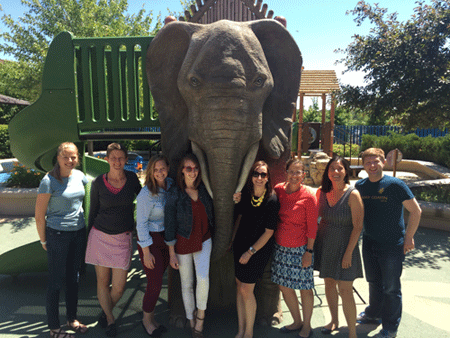Education in Pediatrics Across the Continuum (EPAC)

What is Education in Pediatrics Across the Continuum (EPAC)?
The Education in Pediatrics Across the Continuum (EPAC) project is an exciting educational pathway to test the feasibility of medical education and training that is based on the demonstration of defined outcomes rather than on time, from early in medical school through completion of residency. Those accepted into the EPAC program will transition directly into the Pediatric Residency Program at the University of Minnesota. This pathway started in the Fall of 2013 at four medical schools across the country: San Francisco, Utah, Colorado, and Minnesota. These schools are working in collaboration with the American Association of Medical Colleges (AAMC), the Liaison Committee on Medical Education (LCME), the Accreditation Council for Graduate Medical Education (ACGME), and the American Board of Pediatrics (ABP). EPAC received a grant from the Josiah Macy Jr. Foundation to support the project.
Our Vision
“To create a model of medical education and training seamlessly spanning the UME/GME continuum which is focused on each learner’s individual achievement of the defined competencies and milestones which constitute the professional activities of a pediatrician.” -- AAMC
Interested Students
The Goals of EPAC Are:
- Demonstrate the ability to advance learners based on competency from the beginning of the clinical years through board eligibility
- Demonstrate the role of a specialty-focused longitudinal integrated clerkship in this competency-based advancement
What EPAC Means:
- LIC: The EPAC Longitudinal Integrated Curriculum (LIC) is designed to represent the entire core clerkship curriculum at the University of Minnesota Medical School using, when appropriate, a pediatric patient population as the target demographic. Progress along this curriculum will proceed in a time-variable fashion according to the pace of progress toward entrustment with intern-level responsibilities.
- Transition Phase: Once EPAC learners are deemed entrustable on the 13 Core EPAs for Entering Residency, and have completed the required elements in each core discipline, they will enter the transition phase. Transition phase consists of 4 weeks of a general pediatrics hospitalist sub-internship and 4 weeks of an intensive care sub-internship.
- Enrichment Opportunities: If a learner needs more time in a certain discipline either before or after the transition phase, enrichment opportunities will be created and provided.
- Residency: Once an EPAC learner has completed these phases, they will receive their Doctor of Medicine diploma from the medical school and transition to residency at the University of Minnesota.
What makes a good EPAC Candidate?
- Certain about pediatrics as your specialty of choice
- Certain you wish to remain at the University of Minnesota to complete your training
- Interested and excited about participating in a pilot project in medical education
- Excited about starting your clinical training in a longitudinal clerkship with a pediatric focus
- Ready to increase your level of responsibility based on your demonstrated ability
Discerning if EPAC is Right for YOU!
There are multiple opportunities for first and second year students at the University of Minnesota to discern specialty and programmatic interest for EPAC. We have designed a multi-level process that allows students to be as involved as they wish: EPAC Explore, EPAC Focus, and EPAC Match.
EPAC Explore
In this first phase of the program, EPAC Explore, we provide outreach through the Pediatric Interest Group, three EPAC interest group meetings, and suggest pediatric emphasis for the Service Learning Project.
EPAC Focus
In the second phase of the project, potential applicants are offered an opportunity to participate in the Summer Internship in Pediatrics (SIP), a zero-credit, 2-week elective during the summer hiatus between first and second year. A final informational meeting will be held in the Fall of the student’s second year where application information and requirements will be discussed and final questions can be answered. Potential EPAC applicants are invited to attend an information session and tour of the University of Minnesota Masonic Children’s Hospital during the pediatric residency program’s interview season to familiarize themselves with the residency program.
EPAC Match
The third phase begins once you are accepted into the EPAC program. Each of our 4 cohorts will consist of up to 4 students. The selection process occurs in late January. The first day of the longitudinal integrated clerkship (LIC) begins on the Tuesday after Memorial Day. The first EPAC cohort started in May of 2015.
Curriculum Design: LIC
The design of the LIC (longitudinal integrated clerkship) seeks to maximize continuity of patient care, curriculum, and supervision through three basic elements: continuity experiences with faculty representing the core clerkship disciplines; a strategically built patient panel; and flexible time for the students to follow panel patients into various medical environments.
For 40 percent of their time, students will be assigned to specific faculty for half-day sessions every other week in pediatric emergency medicine, family medicine, internal medicine, ob/gyn, pediatric neurology, child psychiatry, pediatric surgery, and subspecialties. Students will begin their weekly continuity clinic in pediatrics at Fairview University Children’s Clinic.
The students will spend an additional 40 percent of their time engaging with their patient panel in various settings, completing required curricular elements and attending scheduled Practice Meetings.
Finally, the students will have 20 percent of their time protected to pursue independent activities meant to develop their knowledge base and prepare for written examinations. This will be spent in independent study using a host of online learning tools, hands on simulations, and conferences.
Following the LIC, students will enter into transition phase where enrichment will be provided, if necessary, and students will then prepare to transition to pediatric residency at the University of Minnesota.

Program Administration
Patricia Hobday, MD
EPAC Course Director
Emily Borman-Shoap, MD
EPAC Site Residency Director
Molly Wyman, MD
EPAC Site Medical Student Director
Alexandra Behrend
EPAC Course Coordinator